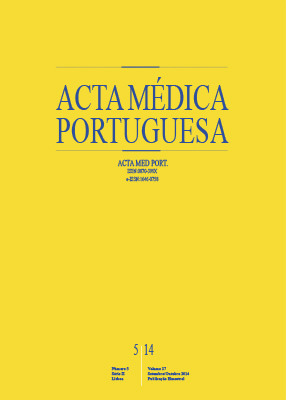Birth Rate and Fertility: Knowledge and Expectations Analysis of 3585 University Students
DOI:
https://doi.org/10.20344/amp.5196Abstract
Introduction: Nowadays, Portuguese birth rate is insufficient to ensure renewal of generations. Women high education levels and labor market integration and increased economic difficulties are some of multiple factors leading to a delay in average parenting age and an increase of infertility; also subject to others such as obesity, smoking and alcohol consumption.
Material and Methods: Transversal epidemiological study, analytical, uncontrolled, from self-filled online questionnaires, promoted by students’ university unions. A sample of 3585 university students was considered and a global and by gender statistic analysis was done through SPSS, Excel was used to build graphics and tables and ArcMap to represent maps. Results: Mainly students from the Health Sciences (40.6%), Universidade de Lisboa (59.4%), female (76.9%), median age of 22; intention to marry/ union 71.0%, parenthood 85.7%. A total of 18.4% smoke, 22.3% consume alcohol and obesity 15.4%; employment (47.4%) and the partner’s will (39.9%) were important determinants for parenthood decision as well as having financial stability to provide a good education (33.6%) and healthcare (38.6%); A total of 53.6% have considered the hypothesis of infertility and highlight above 35 year old maternal age (18.7%), obesity (18%) and female smoking (19.0) as factors. Higher and more significant values for smoking (p = 0.001) and alcohol consumption (p = 0.000) in males were found.
Discussion: The sample seems representative, well distributed among different areas of study, with more female respondents than the university portuguese ratio. There are more students with parenting projects than marriage/cohabitation, in accordance with Portuguese data. Nevertheless, the same students identify the family as a priority in comparison with employment and career. Parenting decisions are tied by social-economic situation but an important factor is the low fertility due to the maternal age delay of the first pregnancy.
Conclusion: University student unions are an excellent instrument to access them; a high number of respondents consider having children but delay the decision; there is a lack of information about the consequences of delaying parenting age and about infertility factors. The negative trend of fertility must be seen as a necessity to develop specific policies.
Keywords: Birth Rate; Students; Universities; Fertility; Portugal.
Downloads
Downloads
Published
How to Cite
Issue
Section
License
All the articles published in the AMP are open access and comply with the requirements of funding agencies or academic institutions. The AMP is governed by the terms of the Creative Commons ‘Attribution – Non-Commercial Use - (CC-BY-NC)’ license, regarding the use by third parties.
It is the author’s responsibility to obtain approval for the reproduction of figures, tables, etc. from other publications.
Upon acceptance of an article for publication, the authors will be asked to complete the ICMJE “Copyright Liability and Copyright Sharing Statement “(http://www.actamedicaportuguesa.com/info/AMP-NormasPublicacao.pdf) and the “Declaration of Potential Conflicts of Interest” (http:// www.icmje.org/conflicts-of-interest). An e-mail will be sent to the corresponding author to acknowledge receipt of the manuscript.
After publication, the authors are authorised to make their articles available in repositories of their institutions of origin, as long as they always mention where they were published and according to the Creative Commons license.









